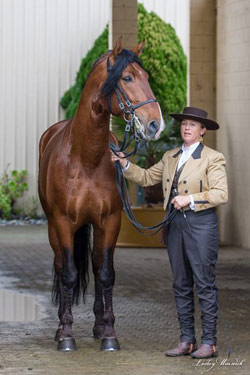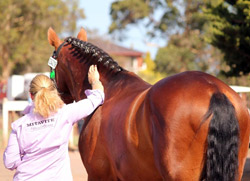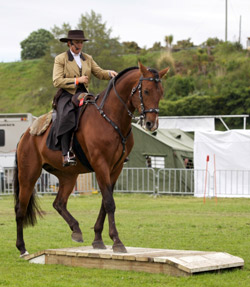“It is the noblest horse in the world, the most beautiful that can be. He is of great spirit and of great courage and docile; hath the proudest trot ... the loftiest gallop, and is the lovingest and gentlest horse, and fittest of all for a king in his day of triumph.”
- Duke of Newcastle about the Iberian horse

Horses have been breed for over 7,000 years on the Iberian Peninsula for use in war and to work cattle. The Templar Knights rode into battle on these lofty steeds. This long period of selection for the attributes of a fine riding horse go some way to explaining the essence of this ancient breed.
The Lusitano takes its name from Lusitania, an ancient Roman name for the region that today is Portugal. Until the 1960’s all horses from the Iberian Peninsula were known as the Andalusian in both Spain and Portugal. At this time the studbooks were separated and the Portuguese horse became known as the Lusitano.
Lusitano horses can be any solid colour and dilutes such as buckskin and palomino are also seen readily. A typical Lusitano is around 15.3hh but many are now being bred taller for sport without losing the genetic traits that make the breed so unique. A Lusitano should have a narrow but well proportioned head with a distinct sub-convex profile. The neck should be thick and arched, with well defined withers, muscular well sloped shoulders and a deep broad chest. The back should be short and very strong with a rounded sloping croup and a low set tail. The legs are sturdy and well muscled with very good feet. Lusitano’s are noted for their smooth but elevated gaits that are comfortable to ride. Although a very majestic and powerful horse, the Lusitano is noted for its intelligence and willing nature, its courage and its sensitivity to the aids.
 The classical outline of a Lusitano with a short back, long legs, high set neck and sloping hind quarters gives these horses a definite ability to collect. This is an important advantage in high level dressage and other disciplines which require a dexterous, mobile horse.
The classical outline of a Lusitano with a short back, long legs, high set neck and sloping hind quarters gives these horses a definite ability to collect. This is an important advantage in high level dressage and other disciplines which require a dexterous, mobile horse.
In Portugal the Lusitano horse is used for every equestrian activity including dressage, working cattle, hunting and working equitation. The Lusitano is also the horse of choice in the Bullfighting arena (in Portugal this is performed on horseback and the bull is not killed) Paulo Catano on of the masters of the bullfighting arena says “Bullfighting is dressage with drama; it goes to the vital meaning of equitation – control. If you can’t control every step, you can get hurt and your horse can get hurt. The best bull-fighting horse has the same characteristics as the dressage horse – the shoulder movements... the engine... a good back to transfer power with lightness”. You only need to watch a few minutes of bullfighting on horseback to know why the bravery, courage, intelligence and nimbleness of the Lusitano makes it the most suitable breed in the world for this discipline.
 Lusitanos also make great horses for top level Olympic sport. Their success in the dressage arena is only just beginning – with a Lusitano featuring in several of Spain’s Olympic and World Games team medals in recent years. Often the entire Portuguese and Brazilian teams at these major champions are mounted exclusively on Lusitano horses. Goncalo Carvalho is one rider who in recent years has bought the Lusitano to the top of the international dressage rankings with a 13th place at the London Olympics with Rubi and more recently high placings internationally with the incredible mare Batuta.
Lusitanos also make great horses for top level Olympic sport. Their success in the dressage arena is only just beginning – with a Lusitano featuring in several of Spain’s Olympic and World Games team medals in recent years. Often the entire Portuguese and Brazilian teams at these major champions are mounted exclusively on Lusitano horses. Goncalo Carvalho is one rider who in recent years has bought the Lusitano to the top of the international dressage rankings with a 13th place at the London Olympics with Rubi and more recently high placings internationally with the incredible mare Batuta.
And it’s not just in the dressage arena they shine either. In 1995 a four-in-hand driving team of pure Lusitano horses was driven to World Cup victory by the Belgian Felix Brasseur and the following year they were crowned World Champions. Driving is a very demanding discipline and the heart, courage and resolve of this incredible breed lends itself to the demands of this sport.
Famous British showjumper John Whitaker also had great success on a pure Lusitano jumping stallion called Novilheiro in the 1980’s. With this horse he was crowned British Champion and later was the leading stakes winner for jumping horses in all of Europe.
 A sport that is new on the international scene and growing quickly in popularity of that of Working Equitation. In this sport the Portuguese riders and horses are unquestionably the best in the world. Working Equitation combines the sport of dressage (but ridden one-handed) with an ease of handling test over obstacles such as jumps, bridges, barrels and poles, followed by a sped test over the same obstacles and finishing with a cattle penning test. It is a sport not only for great horsemen and women, but also agile and intelligent horses.
A sport that is new on the international scene and growing quickly in popularity of that of Working Equitation. In this sport the Portuguese riders and horses are unquestionably the best in the world. Working Equitation combines the sport of dressage (but ridden one-handed) with an ease of handling test over obstacles such as jumps, bridges, barrels and poles, followed by a sped test over the same obstacles and finishing with a cattle penning test. It is a sport not only for great horsemen and women, but also agile and intelligent horses.
An article on the Lusitano horse would not be complete without mentioning one of their greatest fortes – Classical Dressage and High School. Right throughout history the Lusitano has played an important role in equitation. By the 17th Century the Iberian horse was recognised as the very best in the world for the equestrian arts.
Any horse lover’s trip to Portugal’s capital Lisbon is simply not complete without a visit to the Portuguese School of Equestrian Arte (Escola Portuguesa de Arte Equestre). Prepare to be amazed at the beauty of these men and their Lusitano horses bred at the Alter Real stud. The costumes and the age old traditions of fine classical horsemanship are something not to be missed.